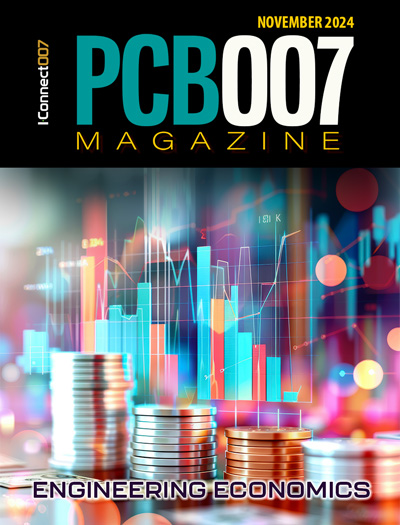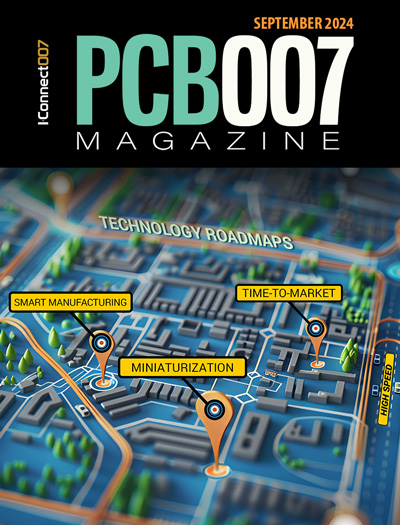-

- News
- Books
Featured Books
- pcb007 Magazine
Latest Issues
Current Issue
Engineering Economics
The real cost to manufacture a PCB encompasses everything that goes into making the product: the materials and other value-added supplies, machine and personnel costs, and most importantly, your quality. A hard look at real costs seems wholly appropriate.

Alternate Metallization Processes
Traditional electroless copper and electroless copper immersion gold have been primary PCB plating methods for decades. But alternative plating metals and processes have been introduced over the past few years as miniaturization and advanced packaging continue to develop.

Technology Roadmaps
In this issue of PCB007 Magazine, we discuss technology roadmaps and what they mean for our businesses, providing context to the all-important question: What is my company’s technology roadmap?
- Articles
- Columns
Search Console
- Links
- Media kit
||| MENU - pcb007 Magazine
Nordson MARCH Launches New-Gen RollVIA Plasma System for R2R PCB Manufacturing
November 29, 2017 | Nordson MARCHEstimated reading time: 2 minutes
Nordson MARCH, a Nordson company, has launched its new-generation RollVIA plasma system, a completely self-contained vacuum plasma system with production-proven, roll-to-roll material handling for flexible printed circuit board (PCB) manufacturing. The new RollVIA incorporates unique vacuum and gas flow technology, new process control technology, updated electrode designs, and superior temperature management with precise control of roll speed, tension, and edge guidance for uniform plasma treatment of substrates as thin as 25 microns. The RollVIA system is used for plasma applications such as surface activation for improved adhesion, carbon removal and descum/desmear for cleaner surfaces, and etchback, which removes a slight amount of dielectric contamination between internal copper planes during production of PCBs.
Roll-to-roll processing, also known as web processing, reel-to-reel processing, or R2R, is the process of creating electronic devices on a roll of flexible plastic or metal foil. The RollVIA plasma treatment system is self-contained so that the vacuum system, plasma chamber, control electronics, and 40 kHz power supply are housed in a single enclosure. Yet the system has a compact 1737 x 2020 x 2323 mm (69 x 80 x 92 in) footprint and can handle and process web widths from 48 to 600 mm. A service-friendly design with three doors for full front and rear access make substrate loading simple and easy.
The RollVIA system's performance capabilities are complemented by low cost-of-ownership features. In addition to the system's compact and service-friendly design, the RollVIA allows for vertical processing so that equal plasma treatment can be applied to both sides of the substrate, maximizing product quality and throughput. The fast vacuum pump down and process cycle times further add to the throughput and productivity of the system. It's configurable with 1, 3, or 5 plasma cells to meet process requirements.
Nordson MARCH will be exhibiting with partner Zhuhai Unite-Effort Industries Co., Ltd. at HKPCA, being held at the Shenzen Convention & Exhibition Center (SZCEC), Shenzhen, China, from 06 Dec 2017 - 08 Dec 2017 in booth 1V03. Stop by to learn how we can help with all your plasma treatment requirements.
About Nordson MARCH
Nordson MARCH is the global leader in plasma processing technology for the semiconductor, printed circuit board (PCB), microelectronics, and life science & medical device manufacturing industries. Nordson MARCH has offices and laboratories worldwide, including California, Europe, Singapore, China, Japan, Korea and Taiwan. With over 25 years of continuous innovation, Nordson MARCH designs and manufactures a complete line of award-winning and patented plasma treatment systems. An expert staff of scientists and engineers is available to assist in the development of plasma processes that improve product reliability and increase production yields. Visit Nordson MARCH here.
About Nordson Corporation
Nordson Corporation delivers precision technology solutions that help customers succeed worldwide. Precision dispensing of adhesives, coatings, sealants, biomaterials, and other fluids, plastic extrusion and injection molding, electronics testing and inspecting, and surface preparation are supported by applications expertise and direct global support. Nordson serves consumer non-durable, durable and high-technology markets, specializing in packaging, nonwovens, electronics, medical, energy, transportation, construction, and product assembly. Founded in 1954, headquartered in Westlake, Ohio, USA, Nordson has operations and support offices in 30+ countries. Connect with Nordson here.
Suggested Items
Fresh PCB Concepts: PCB Design Essentials for Electric Vehicle Charging
11/27/2024 | Team NCAB -- Column: Fresh PCB ConceptsElectric vehicles (EVs), powered by electricity rather than fossil fuels, are transforming transportation and reducing environmental impacts. But what good is an EV if it can't be easily charged? In this month's column, Ramon Roche dives into the role of printed circuit boards (PCBs) in electric vehicle charging (EVC)—and the design considerations.
Unlocking Advanced Circuitry Through Liquid Metal Ink
10/31/2024 | I-Connect007 Editorial TeamPCB UHDI technologist John Johnson of American Standard Circuits discusses the evolving landscape of electronics manufacturing and the critical role of innovation, specifically liquid metal ink technology, as an alternate process to traditional metallization in PCB fabrication to achieve ever finer features and tighter tolerances. The discussion highlights the benefits of reliability, efficiency, and yields as a tradeoff to any increased cost to run the process. As this technology becomes better understood and accepted, even sought out by customers and designers, John says there is a move toward mainstream incorporation.
Fresh PCB Concepts: The Critical Nature of Copper Thickness on PCBs
10/31/2024 | Team NCAB -- Column: Fresh PCB ConceptsPCBs are the backbone of modern electronics and the copper layers within these boards serve as the primary pathways for electrical signals. When designing and manufacturing PCBs, copper thickness is one of the most critical factors and significantly affects the board’s performance and durability. The IPC-6012F specification, the industry standard for the performance and qualification of rigid PCBs, sets clear guidelines on copper thickness to ensure reliability in different environments and applications.
Book Excerpt: The Printed Circuit Designer’s Guide to... DFM Essentials, Ch. 1
10/25/2024 | I-Connect007The guidelines offered in this book are based on both ASC recommendations and IPC standards with the understanding that some may require adjustment based on the material set, fabricator processes, and other design constraints. This chapter details high-frequency materials, copper foil types, metal core PCBs, and the benefits of embedded capacitance and resistor materials in multilayer PCBs.
The Cost-Benefit Analysis of Direct Metallization
10/21/2024 | Carmichael Gugliotti, MacDermid AlphaCarmichael Gugliotti of MacDermid Alpha discusses the innovative realm of direct metallization technology, its numerous applications, and significant advantages over traditional processes. Carmichael offers an in-depth look at how direct metallization, through developments such as Blackhole and Shadow, is revolutionizing PCB manufacturing by enhancing efficiency, sustainability, and cost-effectiveness. From its origins in the 1980s to its application in cutting-edge, high-density interconnects and its pivotal role in sustainability, this discussion sheds light on how direct metallization shapes the future of PCB manufacturing across various industries, including automotive, consumer electronics, and beyond.


